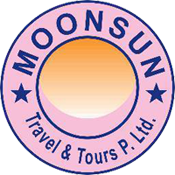

Kunda: In front of Muktinath Temple there are 2 Kunda (Water pond), Where holy dip is believed it can wash away negative karma, the results of one's past negative actions.
Mukti Dhara: Around the temple is a wall from the temple which there are 108 waterspouts (Dhara) name of “Muktidhara”. The 108 faucets in the cast in the shape of bulls' heads, pour fourth-sacred water closely arranged in a semi-circle with a gap of hardly a foot between the faucets, at a height of seven feet. The water from Gandaki River continuously flowing through the mouth of the bull. Pilgrims who visit the temple take a holy bath in each of these spouts. But as the water is ice cold it requires burning desire and courage to take a holy bath here. Hindu devotees take bath under chilled water of 108 waterspouts “Muktidhara” believing that it brings them salvation. It is also believed that the deity was originated from Jumla,far western part of Nepal. It has helped to make this area as center of Tourist attraction. In Janai Purnima Buddhist’s Yar tang Mala celebrated here.
Jwala Mai Temple: Even more sacred is the water that issues from rock inside the ancient Tibetan style “Jwala Mai Temple” sound of flowing river is situated south and a short distance below the of Muktinath Temple. Inside this Gompa, behind a tattered curtain, are small natural gas jest that produce Continuously burning flame, the Jwala Mai temple has a spring and there are three eternal flames “Holy flame from soil”, “Holy flame from rock” and “Holy flame from water” fed by natural gas. Currently two flames are continuously burning. The Hindu believes that this miracle of fire lighting was offering made by Brahma himself , (the creator of universe) set water on fire. Hindus worship the fire as Jwala Mai (Lit. Goddess of fire). The Buddhist believe that Padmasambhav, the great Indian master who inducted Tantric Vajrayana Buddhism in Tibet, meditated at this place. The Buddhist living will show foot prints which they say are those of the great master. They called it Dhola Mebar Gompa.
The holy flame alongside a spring that is the source of the religious importance of Muktinath. It is often possible to see Tibetan woman with elaborate turquoise embedded headdresses, engaged in devotion at these shrine.
Mharme Lha Khang Gompa: After completing prayer and puja at the temple a visit to Mharme Lha Khang Gomba is situated to the North of Muktinath Temple. Mharme Lha Khang is translates as thousand holy lamps. As this monastery dedicated to Guru Rimpoche (Padmasambhava) with his huge clay image is placed center of altar along with bon deities: red Trakpo at right side and blue singe Doma at left side. Since Singe doma is lion headed deity, Hindu worships as Narasimha and name of monastry Narsingh Gompa.
Gomba Samba, a "newly built monastery". It is believed that founder of this monastery Syandol Lama came from Tibet. Originally this monastery was a big hostel for monks that later collapsed and people of Khinga and Jharkot jointly reconstructed it. The main deities monastries are Sakyamuni, Chingresig and Guru Rimpoche. The monastery is situated at left from entrance gate of Muktinath temple complex, would be worth it.
Swaminarayan: One Hindu Guru connected to Muktinath is Lord Shri Swaminarayan, Satguru of Sabij Yoga, the goal of which is the realization of and service to God Supreme. At the end of the 18th century this Satguru practiced severe penance in Muktinath for two and a half months and attained the highest degree of proficiency in Nishkamvrat. In 2003 his followers funded the new wall around Muktinath and raised a small monument for him at Muktinath.
Shaligram: Another attraction for the pilgrimage is the River kali Gandaki from where one can collect fossils of the Jurassic park age. One may find a fossil within a few minutes or it may take hours and without success. However, these fossils can be had from the local people at a price. Shaligram, a black stone fossil if found, is considered sacred and is kept in pooja (prayer) room in the house. It is supposed to be symbol of Lord Vishnu.
Cost Includes:
Cost Excludes:
Note:
# Hotel Rooms Are Subject to Availability.
# Tour Itinerary / Hotel is subject to change
# The vehicle used for transfer & sightseeing will not be at disposal. It will be as per contract & will change sector wise.
# Except Kathmandu & Pokhara there will be guest house stay in Jomsom.
For further detail contact us
Days are relatively warm; especially when there is no wind in the late morning. The appropriate clothing as per the travel period (temperature) and a good walking shoes for rocky and uneven paths are highly recommended. Walking stick would help for those who need support. We suggest you to take normal warm clothes. Light warm jacket, woolen sweater, warm T-Shirts, comfortable shoes, trousers and cotton pants are enough for this trip. We recommended you to bring down jacket for the winter.
Some Frequently Asked Questions by our previous customers.
Other Outbound Countires
Enter your email address to receive all new travel, holiday, destination packages, special offers and other discount information.